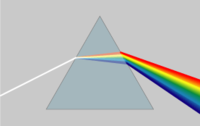
Photo from wikipedia
Abstract This study addresses the development of a statistical tool for predicting the distribution of the size and velocity of droplets in spray caused by the interaction of waves with… Click to show full abstract
Abstract This study addresses the development of a statistical tool for predicting the distribution of the size and velocity of droplets in spray caused by the interaction of waves with a marine object. The Maximum Entropy Principle (MEP) is a statistical tool that allows the prediction of a probability distribution that is consistent with information from the input system. The prediction satisfies constraint equations covering the conservation of mass, momentum, and energy. The velocity distribution of droplets is Gaussian in shape. The effect of a drag force on both the liquid sheet that is formed from the wave impact as well as the downstream distribution of droplets was considered in this simulation. The examination of the mechanisms of turbulence diffusion in a wave at the moment of impact with an object provides a logical, analytical relationship between the wave flows and a spray cloud formation after impact. The model prediction is compared with the experimental data of spray-cloud formation due to wave impact from a lab-scale model, and is found to be in good agreement. The prediction model is then applied to the full-scale model based on the data from previous field observations to predict the droplet size and velocity distributions of spray cloud due to the wave interactions with the vessel.
Journal Title: Ocean Engineering
Year Published: 2018
Link to full text (if available)
Share on Social Media: Sign Up to like & get
recommendations!